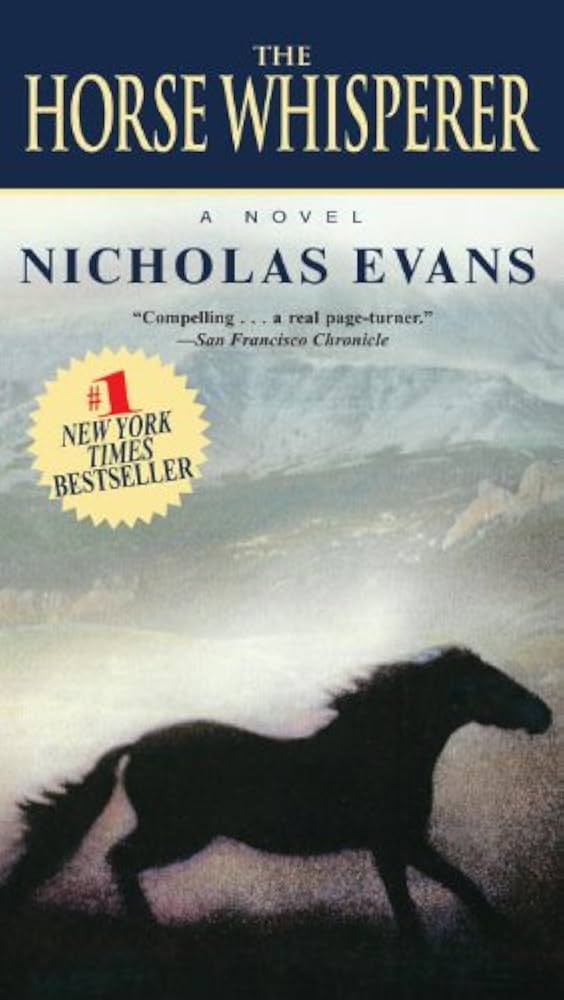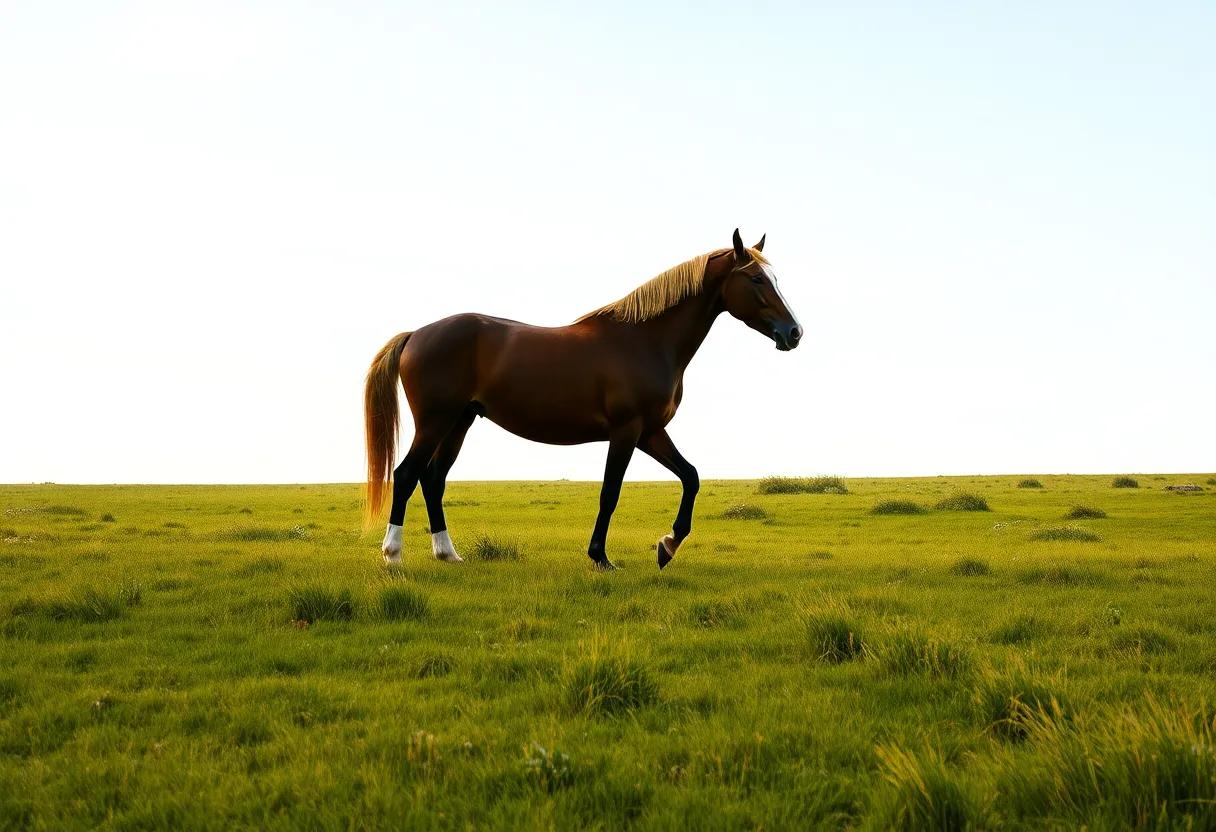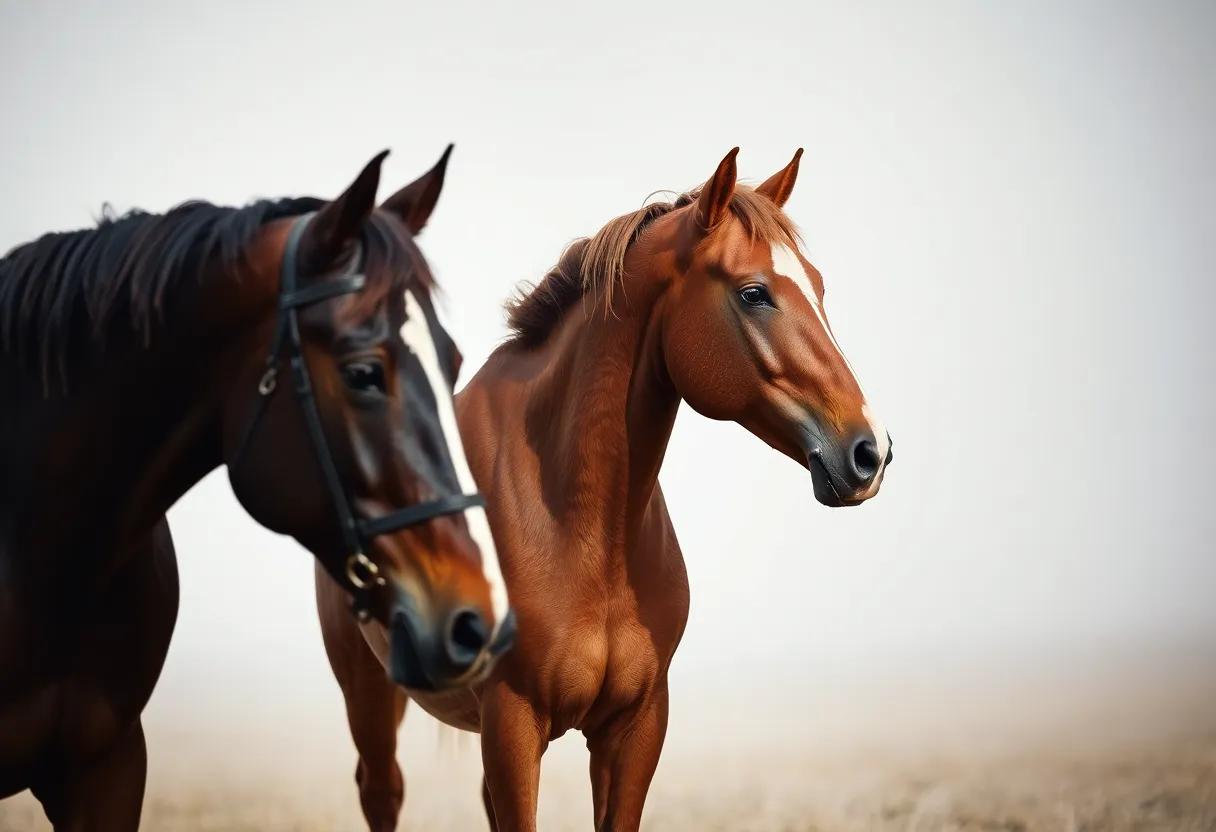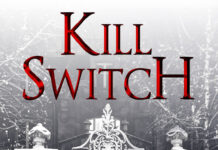In “Unbridling Emotion: A Thoughtful Look at Nicholas Evans’ The Horse Whisperer,” readers are invited to revisit a story that has long captivated hearts with its intertwined themes of healing, redemption, and the profound connections between humans and animals. This review embarks on an exploration beyond the novel’s surface, delving into Evans’ narrative craft and the evocative emotional landscape he paints. Approaching the work with a balanced lens, it seeks to uncover the subtle nuances that have solidified The Horse whisperer as a memorable piece of contemporary fiction, while considering the cultural and literary contexts that shape its enduring appeal.
Exploring the Depths of Human Emotion and Healing Through the portrayal of horses in nicholas Evans’ The Horse Whisperer
Evans’ portrayal invites us to contemplate key themes that intertwine both human and equine experiences:
- Empathy as a Bridge: The way empathy flows naturally between horse and human, healing divides and fostering connection.
- Silent Communication: Understanding beyond words, where gestures and energy tell a deeper story.
- The Journey of Forgiveness: Both characters and horses grapple with past traumas, seeking grace and renewal.
| Element | Human Emotion | Horse’s Influence |
|---|---|---|
| Trust | Rebuilding confidence after loss | Patient presence encouraging openness |
| Anguish | Burden of grief and guilt | Calm demeanor providing solace |
| Hope | Desire for a new beginning | Graceful strength inspiring courage |
The Complex Relationship Between Trauma and Recovery as Portrayed in the Novel’s Interwoven Character Arcs
In The horse Whisperer, trauma is not merely an isolated event but a shared undercurrent that binds the characters in an intricate emotional tapestry. Each character’s journey toward healing reveals different facets of recovery, mirroring the complex process of confronting pain, loss, and denial. As an example, Grace’s physical and emotional scars symbolize the visible and invisible wounds trauma leaves behind, while Tom’s gentle persistence embodies the quite strength required to facilitate healing-not just for the horse, but for human spirits as well.
The novel deftly explores how trauma and recovery are deeply interwoven through moments of vulnerability and resilience. Below is a brief outline highlighting the key emotional arcs and their interplay:
| Character | trauma Experienced | Path to Recovery |
|---|---|---|
| Grace | Accident and emotional withdrawal | Reconnecting through trust and love |
| Tom | loss of connection with people | Patience and intuitive communication |
| Robert | guilt and emotional distance | understanding and forgiveness |
- Interpersonal healing: The characters’ interactions reveal how shared pain can foster deeper empathy.
- The role of nature: The natural world provides a therapeutic backdrop, symbolizing renewal and growth.
- Non-verbal communication: Healing transcends words, captured through gestures and quiet moments.
A Detailed Analysis of the Natural World as a Healing Landscape Within the Story’s Setting and Its Impact on the Narrative
The natural world in The Horse Whisperer is not just a backdrop but an active, living entity that shapes the emotional journey of the characters. The sprawling Montana landscape,with its vast open skies,rugged mountains,and serene rivers,acts as a sanctuary where fractured souls find solace and the possibility of renewal. This healing habitat fosters a profound connection between humans and nature, blurring the lines between emotional wounds and physical scars. The wilderness becomes a silent therapist, its rhythms echoing the characters’ internal struggles and gradual healing. Nature’s role transcends mere scenery; it embodies hope, patience, and conversion-key elements driving the narrative forward.
- Symbolism: the untamed landscape symbolizes freedom and the unspoken pain that characters endure.
- Contrast: The chaotic human experience juxtaposed with the calm and predictability of nature.
- Character Growth: Immersion in nature catalyzes emotional breakthroughs and forgiveness.
This symbiotic relationship between setting and storyline can be further illustrated by how specific natural elements reflect character progress. Consider the following simplified overview:
| Natural Element | Emotional Association | Narrative Function |
|---|---|---|
| Mountain Peaks | Challenge & Overcoming Obstacles | Signify moments of tension and breakthrough |
| Flowing River | Purity & Renewal | Marks cleansing and emotional release |
| Open Plains | Freedom & Possibility | Encourage a new beginning and hope |
How Evans Uses Symbolism and Metaphor to Enhance themes of Connection, Loss, and Redemption Throughout the Book
Evans masterfully weaves symbolism and metaphor as integral threads that bind the emotional fabric of his story. The horse itself transcends its role as a mere animal to become a potent emblem of both innocence and trauma, embodying the fragile connection between human and nature, and the scars that loss can impose. Through the horse’s journey of healing and trust, readers glimpse a silent language of empathy and resilience, making the themes of connection deeply visceral. The natural settings, often described with lush yet melancholic imagery, mirror the inner landscapes of the characters-wide open spaces signaling freedom and possibility, while stormy weather reflects the turmoil of their personal grief and hardship.
Metaphor extends beyond the physical to shape the narrative’s emotional pulse.Take, such as, the recurring motif of “bridging gaps”-not just between broken humans, but between past and present selves striving toward redemption. This is subtly echoed in the interactions between characters who initially confront walls of silence or mistrust but gradually dismantle them through vulnerability and compassionate understanding.Below is a brief look at how key symbols function throughout the prose:
| Symbol | Metaphorical Meaning | Theme Highlighted |
|---|---|---|
| Horse | Broken innocence & healing | connection, Loss |
| The River | Flow of time & emotional cleansing | Redemption |
| Bridges | Overcoming emotional divides | Connection, Redemption |
| Storms | Inner turmoil & conflict | Loss |
The Role of Silence and Communication Beyond Words in Building Trust Between Characters and Horses
In The Horse Whisperer, silence is not merely the absence of sound but a powerful conduit for trust and understanding between humans and horses. the unspoken moments shared, where words fall away, allow the characters and their equine companions to engage on a primal level-through breath, movement, and stillness. This quiet space becomes a language of its own, where tension softens and connection deepens. Trust blossoms not from commands or persuasion,but from mutual respect fostered in thes pauses,emphasizing the profound emotional dialog that transcends verbal communication.
Beyond silence, the novel intricately weaves forms of nonverbal communication-such as gentle touches, eye contact, and body language-that speak volumes. These subtle cues create a bridge between species, underpinning the healing journey each character undergoes. Consider this comparison of communication modes:
| Communication Mode | Effect on Trust | Example in the Novel |
|---|---|---|
| Silence | Calms and centers both horse and human | The quiet moments when Tom consoles the injured horse |
| Touch | Builds warmth and reassurance | Healer’s gentle hand along the horse’s mane |
| Eye Contact | Establishes emotional connection | The trust-filled gaze between Grace and her horse |
- Patience is key; rushed speech disrupts harmony.
- Presence in the moment reveals subtle animal responses.
- Empathy flows naturally without needing words.
Examining the Psychological Realism and Emotional Authenticity in the Characters’ Growth and Interactions
Nicholas Evans masterfully sketches characters whose psychological landscapes are as compelling as their outward journeys. the emotional realism is woven meticulously through their internal struggles and breakthroughs, reflecting true human complexity. For instance,Grace’s transformation is not a sudden shift but a gradual peeling away of layers – grief,guilt,and hope intertwine seamlessly in her interactions. This depth ensures that readers do not merely observe change but experience the rawness of evolving emotions alongside the characters. The interplay between trauma and healing emerges with genuine subtlety, making the characters’ responses feel both unpredictable and relatable.
Evans also excels in layering relationships with nuanced emotional authenticity. The exchanges between Tom Booker and Grace reveal more than affection-they explore trust rebuilding and emotional vulnerability without resorting to melodrama. This subtle approach is echoed in the complex dynamic between humans and horses, where communication defies words.The following table highlights key character interactions and their emotional undercurrents, illustrating how Evans crafts believable growth trajectories:
| Character Pair | Emotional Theme | Growth Element |
|---|---|---|
| Grace & Tom | Vulnerability & Trust | Rebuilding connection after trauma |
| Grace & Her Horse | Loss & Healing | transference of pain and hope |
| Tom & Himself | Isolation & Openness | Embracing empathy through others |
- Psychological depth that invites empathy rather than judgment
- Realistic emotional progress avoiding clichés
- Subtle non-verbal communication adding layers to dialogue
A Critical Look at the Pacing and Narrative Structure That Balances Introspection With Action in the Storytelling
Evans masterfully interweaves moments of quiet reflection with bursts of compelling action, crafting a narrative rhythm that mirrors the ebb and flow of healing itself. Instead of rushing through the plot, the story luxuriates in introspective pauses, allowing readers to delve deeply into the emotional landscapes of the characters. This measured pacing serves a dual purpose: it breathes authenticity into the characters’ internal struggles while keeping the tension alive with well-timed sequences of drama and movement. The deliberate alternation between stillness and motion echoes the therapeutic process,where breakthroughs frequently enough arise from moments of still contemplation just as much as from decisive actions.
The structure of the narrative supports this balance by strategically placing pivotal scenes within a framework that prioritizes character growth over relentless plot progression. Key elements include:
- Slow-building emotional arcs that allow empathy to deepen naturally rather than force-feeding catharsis;
- Interruptions of action that re-engage the audience’s attention and heighten stakes;
- Intertwined subplots that provide texture without overwhelming the core story.
| Element | Effect on Pacing | Impact on Narrative |
|---|---|---|
| Introspective Passages | Slow and immersive | Deep character insight |
| Action Sequences | Quick and engaging | Builds momentum |
| Subplots | varied tempo | Enhances complexity |
The Subtle portrayal of Family Dynamics and Their Influence on Individual Healing Journeys in the Novel
Within this emotional tapestry, healing emerges not as a linear process but as a series of intertwined journeys. key factors highlighted include:
- Communication breakdowns that propel characters toward self-discovery.
- Intergenerational scars shaping perceptions and reactions.
- Moments of vulnerability acting as turning points toward reconciliation.
The subtle shifts in family dynamics within the story underscore the profound impact of emotional intimacy and distance, reminding readers that healing is as much a collective effort as it is an individual journey.
| Family Member | Role in Healing | Emotional Challenge |
|---|---|---|
| Annie | Catalyst for forgiveness | balancing guilt and hope |
| Tom | Embracer of vulnerability | Confronting denial |
| Grace | Heart of resilience | Overcoming fear of loss |
Insights Into How The horse Whisperer Addresses Traditional Gender Roles and Challenges Stereotypes Through Its Characters
The Horse Whisperer masterfully navigates the intricacies of traditional gender roles by presenting its characters in ways that both honor and disrupt societal expectations. Annie MacLean,the story’s female protagonist,embodies strength and vulnerability without being confined to the binary of helplessness or invincibility. Rather than fitting neatly into the archetype of a grieving mother, Annie challenges the stereotype of female fragility by taking active agency in her healing journey and in the rehabilitation of her son and the horse. Meanwhile, Tom Booker’s gentle guidance and emotional intelligence transcend the stereotypical depiction of masculinity; his character illustrates that strength can coexist with sensitivity, and that healing is not bound by gender.
Through this rich interplay of character traits, the novel reframes conventional perspectives by:
- Highlighting emotional complexity in both men and women
- Subverting expected caregiver roles frequently enough assigned to women
- Portraying vulnerability as a shared human experience, irrespective of gender
Below is a concise overview of the primary characters and how they relate to or challenge gender norms:
| Character | Traditional Role | How They Challenge It |
|---|---|---|
| Annie MacLean | Grieving mother, emotional | active healer, resilient, assertive |
| Tom Booker | Stoic male figure, rugged horseman | Empathic, patient, nurturing |
| Grace MacLean | Innocent daughter, fragile | Independent, courageous in recovery |
The Use of Descriptive Language to Create Vivid, Immersive Scenes That Draw Readers into the Emotional Landscape
This immersive quality extends beyond visual elements,embracing sounds,textures,and even the silence between words. Evans’ use of descriptive language nurtures a sense of intimacy, allowing a nuanced exploration of complex emotions without overt exposition. Consider the way a single glance shared between characters is framed by the whispering wind or the distant neigh of a horse – these moments become charged with meaning, underscoring unsaid feelings and drawing the reader deeper into the story’s emotional landscape. The result is a narrative that doesn’t just tell but allows you to feel, embodying the profound connection between humans and nature.
Recommending The Horse Whisperer for Readers Interested in Emotional Depth, Equine Culture, and Thoughtful Literary Exploration
For those fascinated by equine culture, Nicholas Evans presents an authentic lens through which the traditions and subtleties of horse whispering come alive. The book invites readers to appreciate a quiet world where communication surpasses words and the slightest gesture speaks volumes. Its thoughtful prose engages literary enthusiasts who savor nuanced storytelling enriched with emotional depth and cultural insight. Whether you are drawn by the resilient spirit of the characters or by the poetic depiction of nature’s rhythms, this novel stands out as a heartfelt exploration of humanity intertwined with the animal world.
- Deep emotional resonance with themes of healing and trust
- Insight into the forgotten art and culture of horse whispering
- Thought-provoking, elegant prose suitable for literary readers
- Exploration of interpersonal relationships through nature’s lens
| Aspect | Appeal to Readers |
|---|---|
| Emotional Depth | Rich character development and heartfelt storytelling |
| Equine Culture | Authentic depiction of horse training and natural horsemanship |
| Literary Exploration | Subtle themes and evocative writing style for contemplative readers |
How This Novel sits Within the Broader Context of Contemporary Literature About Human-Animal Bonds and Healing
In the vast landscape of contemporary literature exploring the intricate relationships between humans and animals, Nicholas Evans’ The Horse Whisperer stands out for its profound emphasis on emotional restoration through connection with nature. Unlike many narratives that primarily highlight conflict or domination, Evans weaves a tale where healing emanates from empathy and mutual understanding. This novel enriches the ongoing dialogue around animal-human bonds by portraying horses not merely as companions but as active participants in trauma recovery. Its nuanced depiction challenges readers to reconsider traditional perceptions and recognize the therapeutic potential harbored within interspecies communication.
The novel’s thematic resonance aligns with current literary works that advocate for holistic healing-where psychological wounds can be soothed through authentic relationships with animals. In a contemporary context often marked by alienation and digital detachment,Evans’ story invites a return to grounding experiences. Below is a brief comparison showcasing where The Horse Whisperer fits among peers in this genre:
| Book | Primary Focus | Type of animal | Healing Aspect |
|---|---|---|---|
| The Horse Whisperer | Emotional trauma and recovery | Horse | Mutual empathy & communication |
| Watership Down | Survival and community | Rabbits | Social bonds & resilience |
| Marley & Me | Daily life and companionship | Dog | Unconditional love & loyalty |
| Call of the Wild | Primal instincts and freedom | Dog | Self-discovery & adaptation |
Behind the Story Crafting The Horse Whisperer: An Overview of Nicholas Evans’ Background and Inspirations as a Writer
Nicholas Evans’ journey to penning The Horse Whisperer was deeply influenced by a rich tapestry of life experiences and passions. Before venturing into fiction, Evans worked as a journalist and a film producer, honing his eye for detail and storytelling. His enduring fascination with horses stemmed from childhood encounters on his family’s farm and deepened through years of riding and observing equine behavior.This intimate connection lent authenticity to his portrayal of the bond between humans and horses, capturing the quiet language of trust that transcends words. Evans’ unique blend of rural upbringing and media savvy allowed him to craft a narrative that feels both cinematic and profoundly grounded in reality.
Beyond his personal background, Evans drew inspiration from traditional horsemanship and the natural landscapes of the American West, weaving in themes of healing and redemption that resonate universally. His research included interviewing real-life horse whisperers and immersing himself in the culture surrounding these mystical guardians of equine wisdom. To illustrate his diverse inspirations,consider the following snapshot:
| Influence | Impact on the Novel |
|---|---|
| Rural upbringing | Authentic depictions of countryside life |
| Journalistic career | Meticulous storytelling and vivid detail |
| Real horse whisperers | Believable and sensitive horse training scenes |
| American West landscapes | Evocative settings symbolizing freedom and healing |
In closing, offers more than just an analysis-it invites readers to pause and reflect on the delicate dance between human vulnerability and the natural world. Whether you are a longtime admirer of Evans’ work or approaching it for the first time, this review gently guides you through the emotional currents that make The Horse Whisperer resonate across time. It’s a reminder that sometimes, the quietest connections carry the most profound truths.











